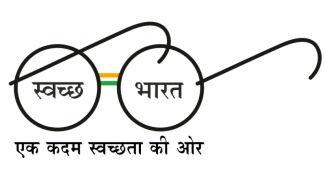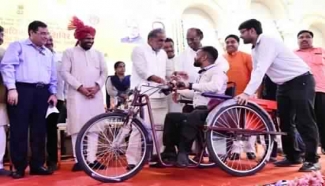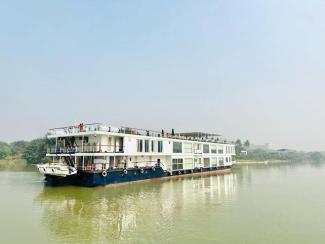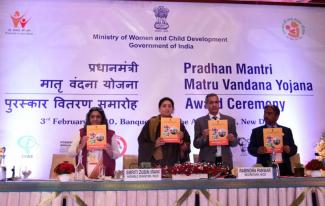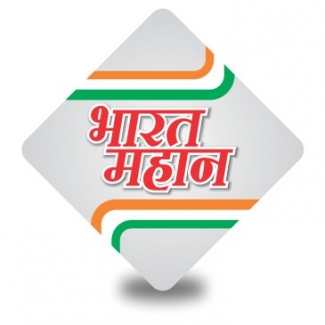
Union Minister of Water Resources, River Development and Ganga Rejuvenation, Road Transport & Highways and Shipping Shri Nitin Gadkari has said that Nirmal Ganga is the biggest priority of his Ministry, and all efforts will be made to ensure that the Namami Gange Programme shows good progress by the end of next year. Shri Gadkari was speaking on the occasion of signing of a tripartite agreement between National Mission for Clean Ganga (NMCG) and the state level executing agencies Uttarakhand Pey Jal Nigam and Uttar Pradesh Jal Nigam, with concessionaires for setting up of India’s first Sewage Treatment Plants under Hybrid Annuity mode, at Haridwar and Varanasi.
The Minister further said that about 3000 MLD sewage from 97 cities on its banks are the biggest source of pollution for Ganga. Of this, 1750 MLD sewage comes from just 10 cities. He said 34 projects worth Rs 3581 crore had been sanctioned for Ganga cleaning between 2008-2014, while 56 projects worth Rs 9630 crore have been approved since 2014 till date. Mentioning that 18 of these projects are ready, Shri Gadkari said the other projects will also be done by March 2019. He said that a committee headed by MoS Dr Satya Pal Singh will monitor the projects on a monthly basis.
Regarding the agreement for Hybrid Annuity mode (HAM) based STPs for Haridwar and Varanasi signed today, the Minister said the agreement is a major step forward in realizing the dream of Nirmal Ganga as it is the first time ever in India that Hybrid Annuity-based PPP mode is being applied in sewerage sector. Under this agreement the maintenance of the project will be the responsibility of the concessionaire for which there will be performance based phased manner of payment. This would ensure continued performance of the sewage infrastructure assets created due to better accountability, ownership and optimal performance.
The 50 MLD STP in Varanasi was awarded to a consortium led by Essel Infra Projects Limited at an estimated cost of Rs 153.16 crore. In Haridwar, HNB Engineers Private Ltd. won the contract for a total sewage treatment capacity of 82 MLD (68MLD in Jagjeetpur & 14MLD in Sarai) at an estimated cost of Rs 171.53 crore. The awarded projects would ensure that untreated sewage does not flow into river Ganga, thus giving a boost to India’s flagship Namami Gange program. The construction of these two new/ green field STPs will commence shortly.
A second set of sewage treatment projects under HAM are on the anvil. The upcoming projects which have already been sanctioned under HAM are STPs at Naini, Jhusi, and Phaphamau at Allahabad (72 MLD), STPs at Unnao, Shuklaganj, and Bithoor along with Kanpur (21.4 MLD), STPs at Digha and Kankarbagh in Bihar (150), STPs at Kolkata and Howrah (141 MLD) STPs at Farukhabad (30 MLD), STP at Bhagalpur (65 MLD). Tender documents for 10 of these projects are being prepared. NMCG has also appointed strategic consultants for PPP design and transaction advisory support for integration of sewage treatment infrastructure in Kanpur, Allahabad, Patna and Kolkata.
Shri Gadkari informed that Prime Minister Shri Narendra Modi will lay the foundation stone for setting up four STPs of 140 MLD in Patna on 14th October, 2017. The total cost of these projects would be Rs 738.14 crore.
The Minister also launched an interactive website on National Mission for clean Ganga (NMCG) to enable the corporates to undertake CSR activities for Ganga Rejuvenation today. This webpage, which will be available on NMCG website at www.nmcg.nic.in, gives the details of projects and activities which can be taken up under CSR funds , and will enable applying for the same online. Shri Gadkari called upon the private sector to join the herculean task of Ganga Rejuvenation with their resources, reach and experience by taking up projects of Namami Gange under CSR activities. The Minister also called upon the religious institutions and NGOs to adopt villages along the river Ganga and develop them as Aadarsh Ganga Gram. He also said that Water Resources Ministry is exploring innovative ways for utilization of recycled sewage by power plants, sugar industries, distilleries, tanneries as also for extracting bio – CNG, methane and Carbon Dioxide.






